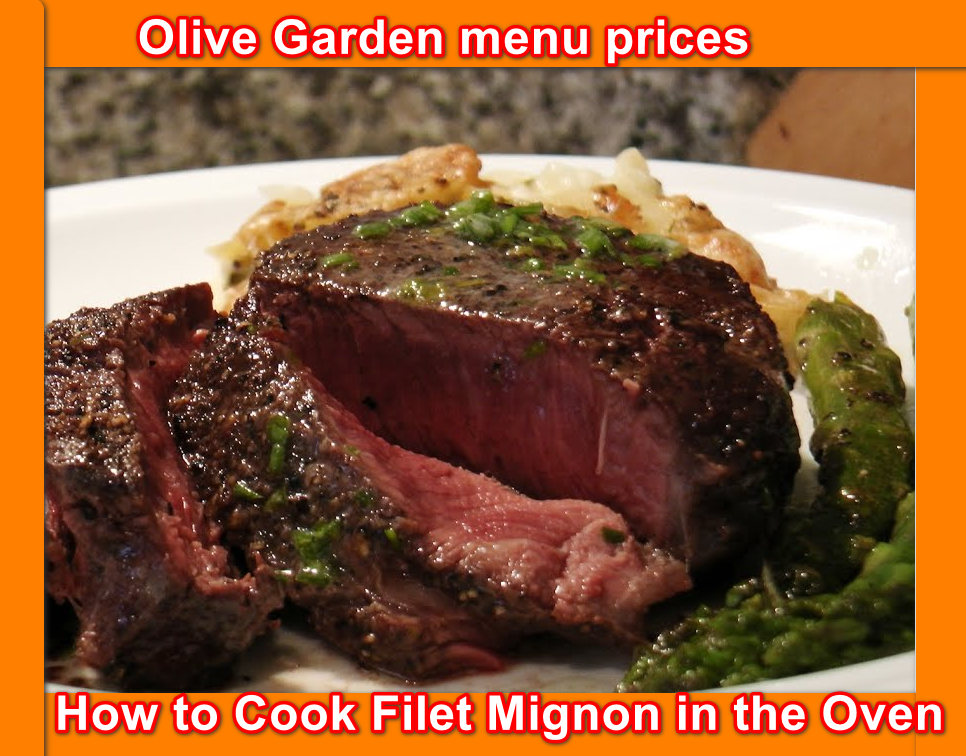
Filet mignon is regarded as the pinnacle of lavish feasts. Mastering its preparation can elevate any meal into an extraordinary affair. Known for its incomparable tenderness and richness, this prized cut demands skill in the kitchen—however, the oven produces Results with minimal effort. In this guide, we impart step-by-step instructions as well as guidance from experts in the craft to consistently yield a filet mignon befitting the finest steakhouses from the comfort of your home kitchen. Various techniques are highlighted to attain the ideal texture and savor within every bite. Patience and practiced hands result in the rewards of a meltingly tender cut seasoned with flavor through and through. if you need to other Cooking Gudilne Follow Olive Garden Menu Resturent .
Why Choose Filet Mignon?
Filet mignon comes from the tenderloin, one of the least-used muscles of the cow. This select cut is exceptionally tender and lean, resulting in a melt-in-your-mouth experience regardless of how done the steak is cooked – whether rare, medium-rare, or up to well-done. Versatile filet mignon can take center stage on the plate for both momentous celebrations and casual weeknight indulgences at home alike. Whether you want your palate pampered or simply crave a decadent treat, you can’t go wrong with this luxurious steak that tastes every bit as good as it looks.
What You’ll Need
Before diving into the intricate cooking process, let us first gather the essential elements required:
Ingredients:
Beef tenderloin steaks of substantive thickness ranging from approximately 1.5 to 2 inches thick, kosher salt seasoned liberally, freshly ground black pepper, olive oil or oil with a lofty smoke point such as grapeseed, unsalted butter softened to a spreadable consistency, fresh herbs whether thymes delicate branches, rosemaries pine-scented needles or curly leafed parsleys, and if desired a few cloves of pungent garlic.
Equipment:
A sturdy oven-safe skillets surface, most suitably a cast iron pan seasoned to a non-stick sheen, tongs for deft manipulation of the steaks within the sizzling skillet, a meat thermometer for ascertaining the internal temperature indicates perfection, aluminum foil for loosely tenting the cooked portions to retain their warmth, and an optional basting brush for artsy applications of savory pan drippings.
Step-by-Step Guide to Cooking Filet Mignon in the Oven
Choose the Finest Cut
When shopping for filet mignon, seek steaks that are evenly sliced and have a vibrant crimson hue. Opt for cuts measuring approximately one and a half to two inches thick, as these provide the optimum balance between a seared outer shell and a succulent center.
Allow the Steak to Warm at Ambient Temperature
Take your steaks out of the fridge at minimum thirty minutes before cooking. Permitting them to achieve room temperature guarantees consistent cooking.
Preheat Your Range and Skillet
Preheat your oven to four hundred degrees Fahrenheit. Concurrently, place your oven-safe skillet on the stove top over medium-high heat to achieve searing heat.
Generously Season
Pat the steaks dry with a paper towel. Then, bountifully seasoning both aspects with kosher salt and freshly ground pepper. An opulent seasoning enhances the natural flavors of the filet mignon.
Sear the Steak on the Stovetop
Add a tablespoon of oil to the hot skillet. Once the oil shimmers, place the steaks in the skillet and sear each aspect for two to three minutes until a golden-brown shell forms. Don’t fail to sear the borders by grasping the steak with tongs.
Transfer to the Oven
Subsequent searing, transfer the skillet directly to the preheated oven. Cook the steaks for approximately five to seven minutes, contingent on your preferred level of readiness:
- Rare: one hundred twenty degrees Fahrenheit
- Medium-rare: one hundred thirty degrees Fahrenheit
- Medium: one hundred forty degrees Fahrenheit
- Medium-well: one hundred fifty degrees Fahrenheit
- Well-done: one hundred sixty degrees Fahrenheit
Utilize a meat thermometer to check the internal temperature for precision.
Baste with Butter and Herbs
For an added layer of rich, savory flavor, generously baste the seared steaks throughout their remaining cooking time with a blend of melted butter and fresh thyme leaves. Spoon the fragrant herb-infused butter over the top of the steaks at regular intervals, allowing its warmth to penetrate the tender meat.
Allow the Steaks to Rest
Remove the steaks from the hot oven and transfer them to a warmed serving platter. Tent loosely with aluminium foil and permit the cuts to sit undisturbed for at least ten minutes. This critical step permits the drippings to be reabsorbed into the fibers, resulting in steaks that are both tender and moist.
Serve and Savor
Once rested, use a sharp knife to thinly slice the steaks against the grain, keeping the strips as long as feasible. Arrange artfully on plates and garnish with your side of choice, whether roasted asparagus spears, buttery mashed potatoes, or a crisp salad. Present family or guests with the flawlessly cooked cuts to enjoy the fruits of your labor.
Expert Tips for Perfect Filet Mignon
Employing a Thermal Sensor Guarantees Success
Investing in a quality meat thermometer abolishes unpredictability in cooking. It confirms achieving the suitable level of doneness consistently.
The Sear Forms Flavor
The sear manufactures a tasty crust, locking in juices while enhancing texture. Ensure the skillet is sufficiently heated before adding the steak.
Cook Portions Separately if Needed
Divide the steaks into batches for cooking if necessary. Overfilling can decrease temperature and hinder a proper sear.
Personalize with Different Flavorings
Feel encouraged adjusting your filet mignon with unique seasonings or compound butters. Perhaps garlic herb butter, truffle butter, or a balsamic reduction can offer novelty.
Select a Suitable Oil
Utilize oils with a high smoke point like avocado or grapeseed oil to avoid burning during the searing process.
Common Mistakes to Avoid
Cooking Straight from the Fridge
Allowing chilled cutlets to sit wrapped on the counter for an hour or more before being placed on a preheated surface is crucial for an evenly cooked meal. Patience in the preparation is key to savor every bite.
Overcooking Neglect
While some may prefer their filet well-done, most appreciate the supple texture and melt-in-your-mouth quality of medium rare to medium doneness. Overattention to the grill can dry out the delicate meat and ruin the experience on the palate.
Skipping Rest Means Rushing the Result
The moment cooking concludes, cutting into the tenderloin releases juices that could otherwise enrich each piece if briefly allowed to reabsorb. Taking just five minutes for the meat to settle ensures the satisfaction of a juicier serving.
Choosing the Wrong Cookware
Whether frying indoors or roasting outside, confirming the suitability of pans, skillets, and dishware for the desired heating method protects the quality of the meal. Cast iron conducts heat evenly and maintains a steady temperature throughout the cooking process.
Serving Suggestions
Filet mignon pairs beautifully with a variety of sides and sauces. Here are some ideas to elevate your meal:
- Classic Pairings: Mashed potatoes, steamed green beans, or creamed spinach.
- Sauces: Red wine reduction, béarnaise sauce, or peppercorn sauce.
- Light Options: A crisp arugula salad with lemon vinaigrette or roasted Brussels sprouts.
For beverages, a bold red wine like Cabernet Sauvignon or a dry Merlot complements the richness of the filet mignon.
Final Thoughts
Cooking a succulent filet mignon in the oven requires minimal effort yet yields superb results guaranteed to elevate any home-cooked meal to that of a five-star dining extravaganza. With adherence to the enumerated tactics as well as utilization of the previously mentioned hints and strategies, one shall expeditiously attain mastery of this opulent entree. Accordingly, procure your chef’s hat, preheat the stove, and delight your loved ones with a faultlessly prepared filet mignon of unparalleled tenderness and flavor! Furthermore, embellish thy table with a bottle of your finest red wine and lit candles that your guests may feel as if they have been transported to the Ritz amidst the comfort of your own abode.
FAQ
For filet mignon, what thickness yields the perfect cook?
Many recommend cutting steaks 1.5 to 2 inches thick for filet mignon. This allows for a beautiful brown crust to form without overcooking the tender interior.
Is cast iron truly necessary when searing filet mignon?
While cast iron excels at searing due to outstanding heat retention and distribution, you can use any oven-safe skillet. Just be sure it can withstand high temperatures.
Does filet mignon need marinating before cooking?
Filet mignon’s supreme tenderness means marinating is unnecessary – a light seasoning of salt and black pepper brings out its natural flavor.
How can I verify the doneness of my filet mignon steak?
For medium-rare, aim to cook filet mignon to an internal temperature of 130°F as measured with a meat thermometer. Refer to the temperature guide for other desired doneness levels.
Can I finish cooking filet mignon under the broiler instead of the oven?
Yes, you can sear filet mignon in a skillet on the stovetop then transfer to the broiler for a few minutes to develop an extra crispy, caramelized crust. Be vigilant to prevent overcooking.
What’s the best way to enjoy leftover filet mignon?
Store any remaining filet mignon in an airtight container for 3 days maximum in the fridge. Reheat gently in a skillet with a small knob of butter until heated through to maintain moisture and tenderness.


